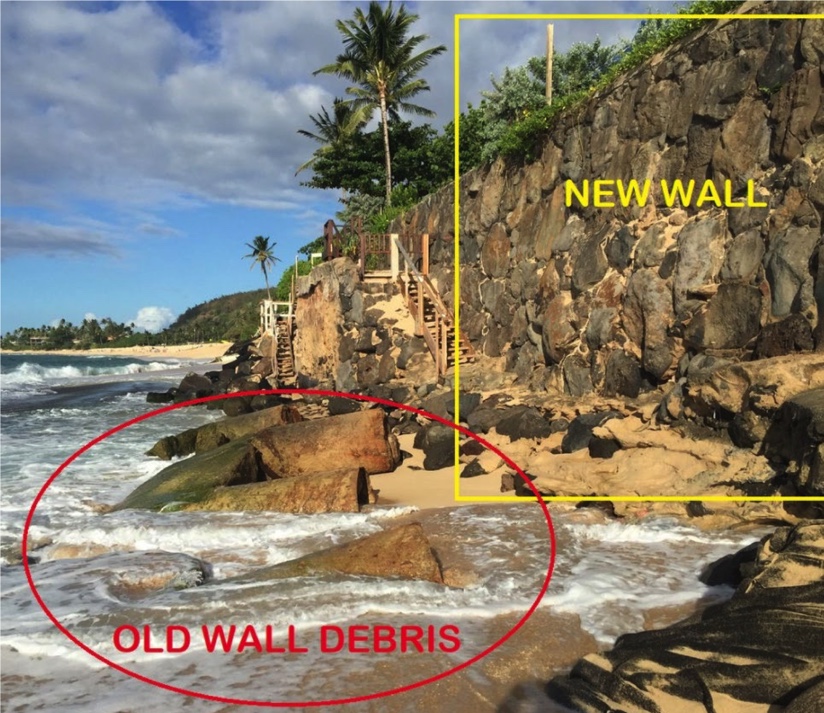On November 10, the state Board of Land and Natural Resources approved a settlement over an unauthorized seawall built by James and Denise O’Shea in 2017 after the one that had fronted their Sunset Beach home for decades collapsed.
The O’Sheas argued that they built the wall on their property. The state argued that the wall sat on the public beach and sought a court order to remove the wall. A jury-waived trial was expected to have begun this past August, but attorneys for both sides had agreed to settlement terms beforehand. The settlement required Land Board approval.
At the board’s meeting last month, Michael Cain, administrator for the Department of Land and Natural Resources’ Office of Conservation and Coastal Lands, recommended approving the settlement, which would make removal of the seawall a restrictive covenant on the O’Sheas’ property. (The property was for sale as of press time.)
Cain also recommended that the board declare that the seawall removal is exempt from any requirement to conduct an environmental assessment.
He said it’s unknown who built the original seawall, but it appeared to have been built as part of a county park. “As far as we know, no government agency built it,” he said. In any case, he added, the wall was built outside of property boundaries.
According to coastal geologist Bradley Romine with the University of Hawai‘i’s Sea Grant program, the beach fronting the O’Shea’s property is eroding at a rate of about 0.7 feet per year.
“When installed on an eroding beach, seawalls lead to beach narrowing and beach loss through a process called ‘coastal squeeze.’ As sand continues to be washed away fronting the new seawall by ongoing erosion, the seaward edge of the beach (i.e., beach toe) continues to move landward toward the base of the fixed seawall, narrowing and ultimately pinching-off the beach. Beach sand is impounded behind the New Seawall that would otherwise be eroded through coastal processes to nourish and sustain the beach system, compounding the erosion and beach loss,” an OCCL staff report states.
“OCCL and the O’Sheas have negotiated a proposed settlement agreement which would give the O’Sheas a reasonable amount of time to remove the new seawall but would enable the State to immediately remove the wall itself, impose fines against the O’Sheas, and hold the O’Sheas accountable for the costs of the wall removal if the O’Sheas do not comply. The agreement would run with the property and would thus be enforceable against any new owners should the O’Sheas sell the property. The agreement would thus avoid the delay, costs, and uncertainty of litigation,” it adds.
Under the settlement, the O’Sheas would have to remove the wall by December 31, 2024 and would receive assistance from the state in obtaining necessary permits. If circumstances arise that make it impossible to meet that deadline, the O’Sheas may ask the Land Board for additional time.
“However, the mere fact that surf becomes higher in the winter months is not in itself a circumstance outside of the O’Sheas’ control; the O’Sheas agree to plan so that removal can take place when conditions allow,” the report states.
The O’Sheas would be required to obtain insurance to cover any liability arising from the seawall removal or before removal. They would also indemnify the state from any claims associated with the new seawall or its removal. However, the state would not be indemnified from any claims brought by adjacent landowners alleging that the seawall should not be removed.
The O’Sheas would also be liable for fines and administrative fees totaling $52,500. If they remove the wall by the deadline(s), removal costs would be credit- ed against the fine.
The settlement would require the parties to execute and record in the Bureau of Conveyances a stipulated judgement ordering the seawall removal. The judgement would not be executed until the latter of January 1, 2025 “or such other extensions as may be granted by the BLNR.”
Land Board member Vernon Char asked Cain why it would take two years to effectuate the judgement.
Cain replied that the deadline takes into account “seasonal considerations” and also allows time for the development of a longer-term, more holistic approach to the erosion problems on the North Shore.
— Teresa Dawson
For Further Reading
“New & Noteworthy: Kihei High, Seawall Settlement,” September 2022;
“Courts Roundup,” August 2022;
“Seawall Case Heads to Settlement Talks With Court Rulings in the State’s Favor,” November 2021;
“New & Noteworthy: Sunset Seawall, Maui Water Permits,” February 2021.


Leave a Reply